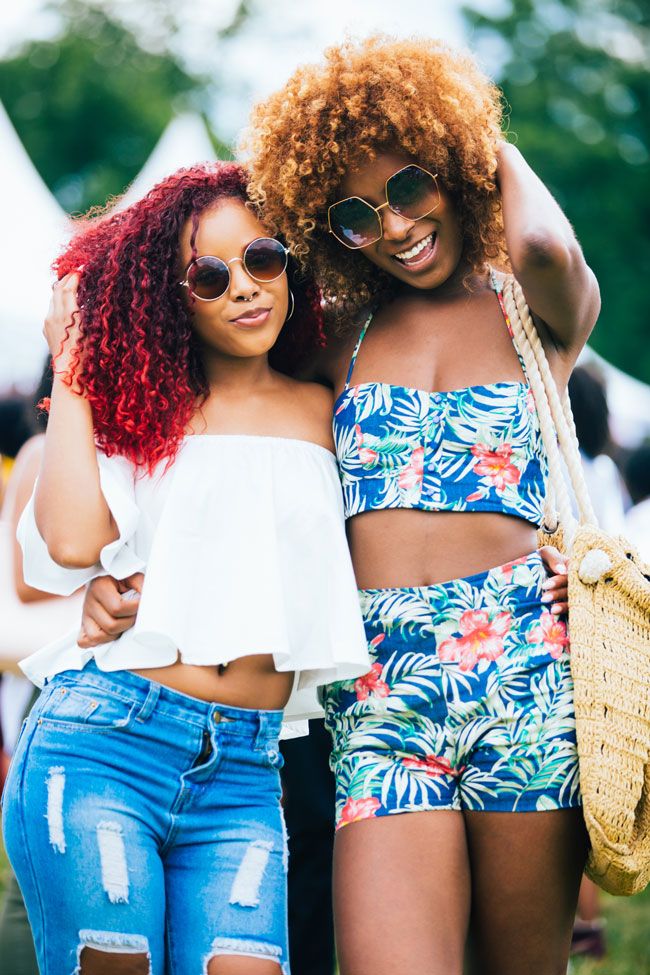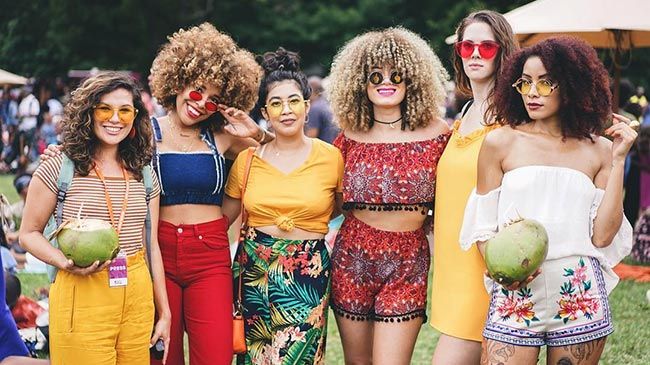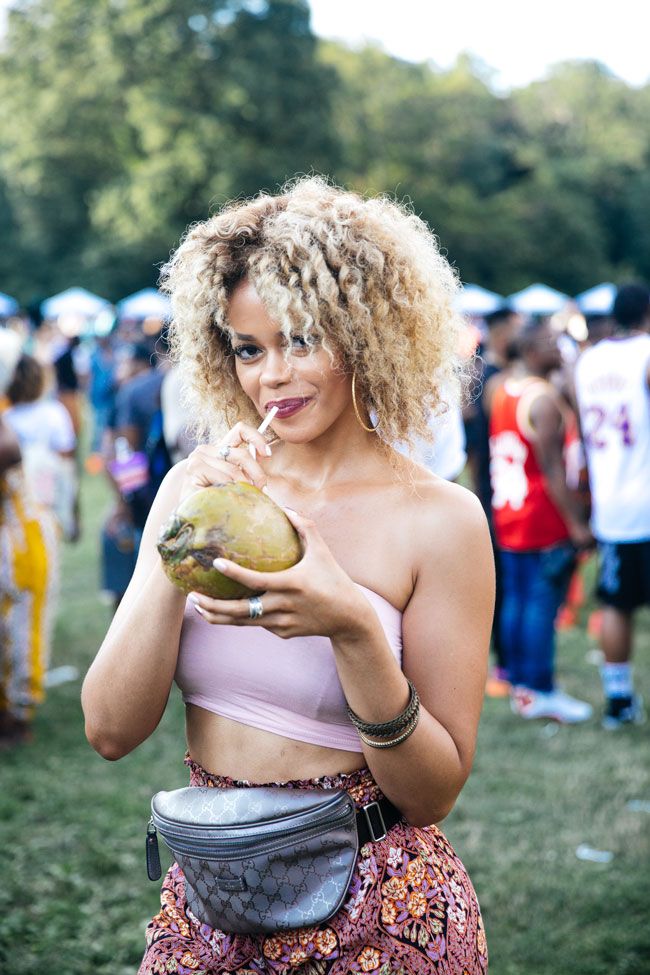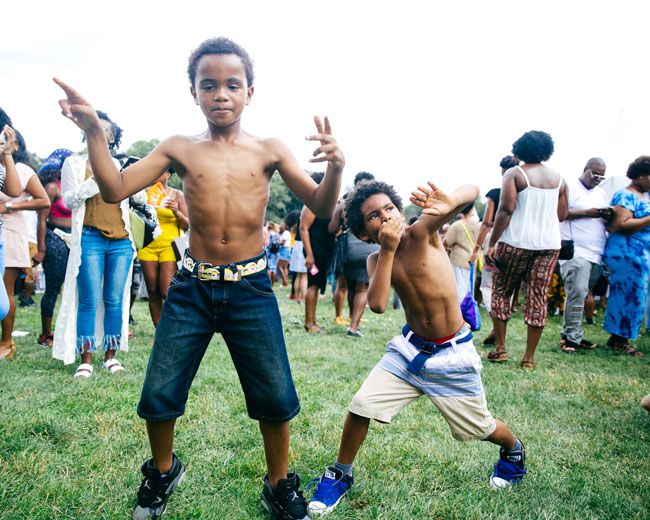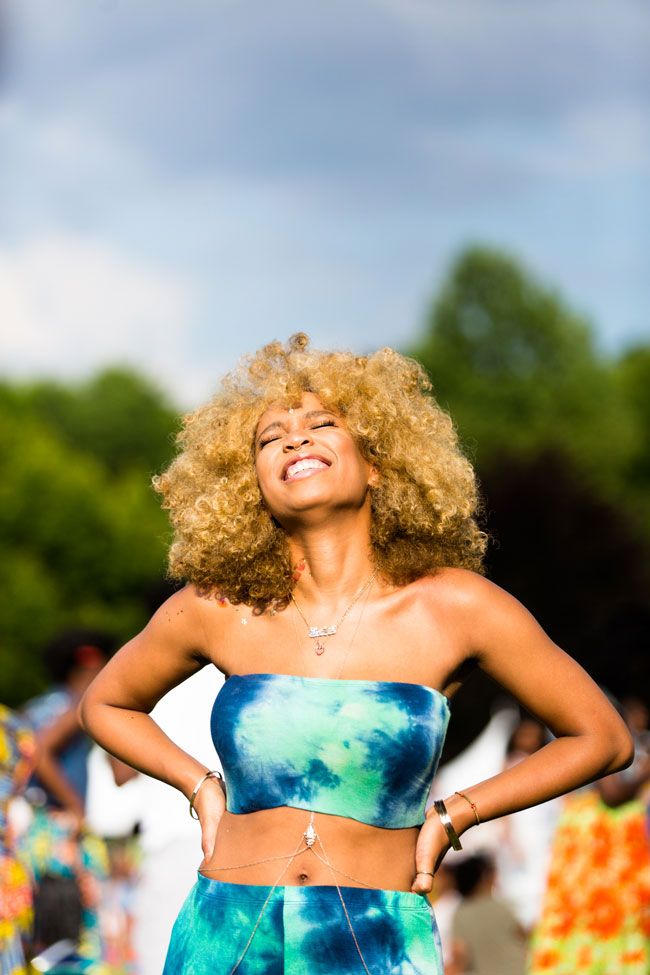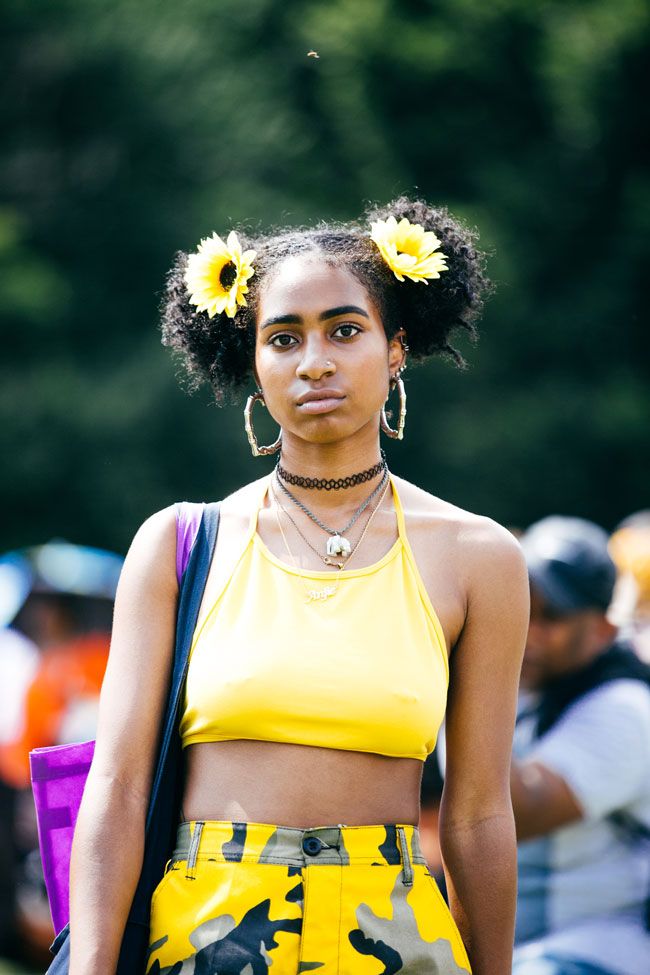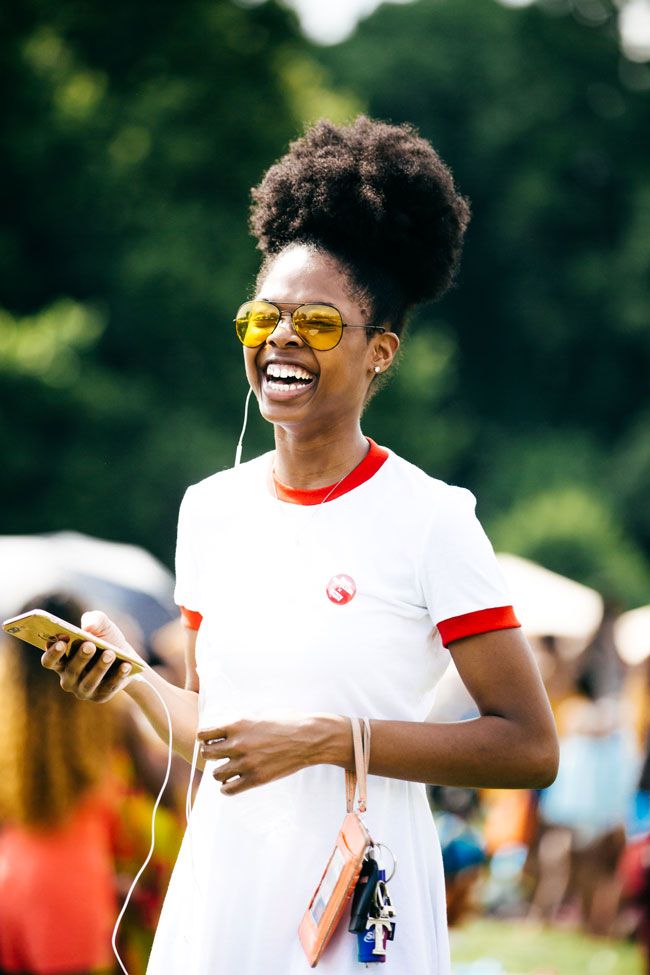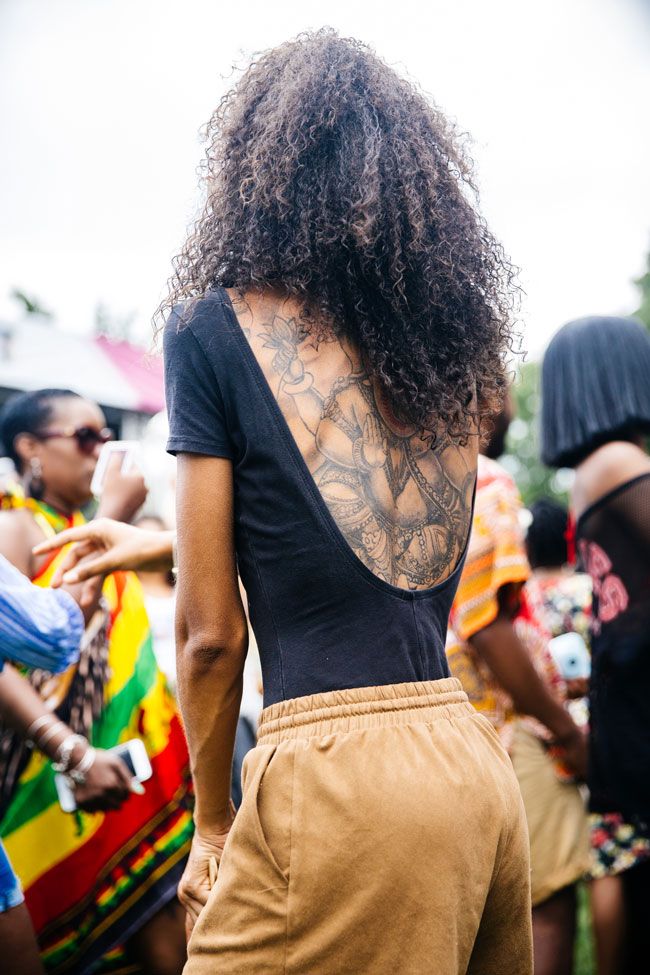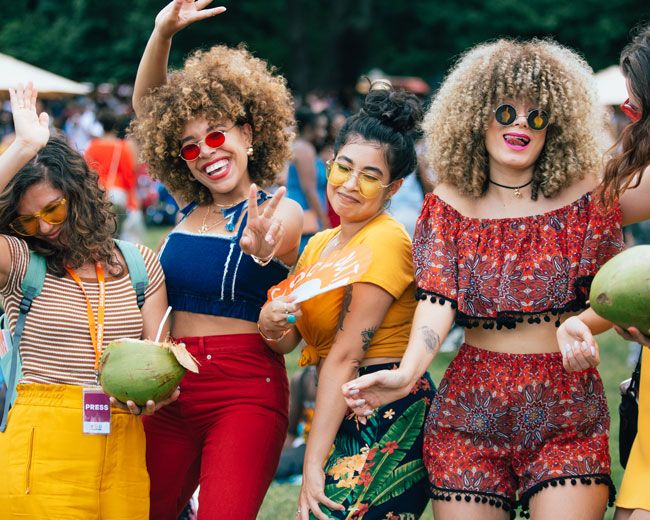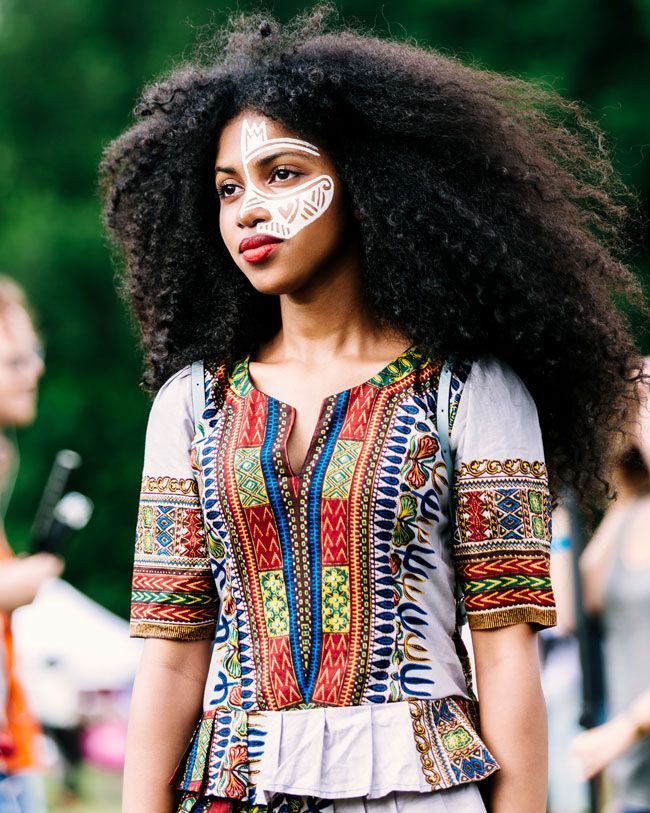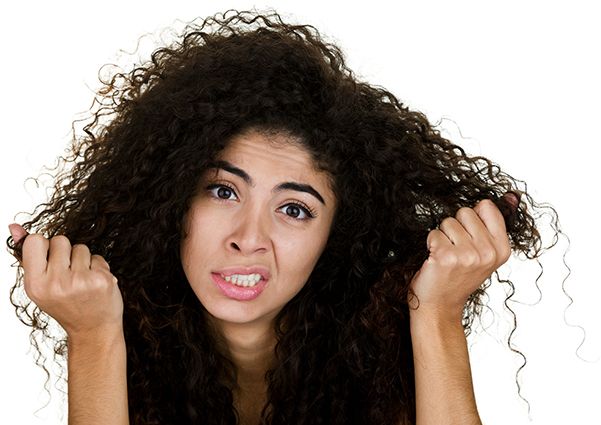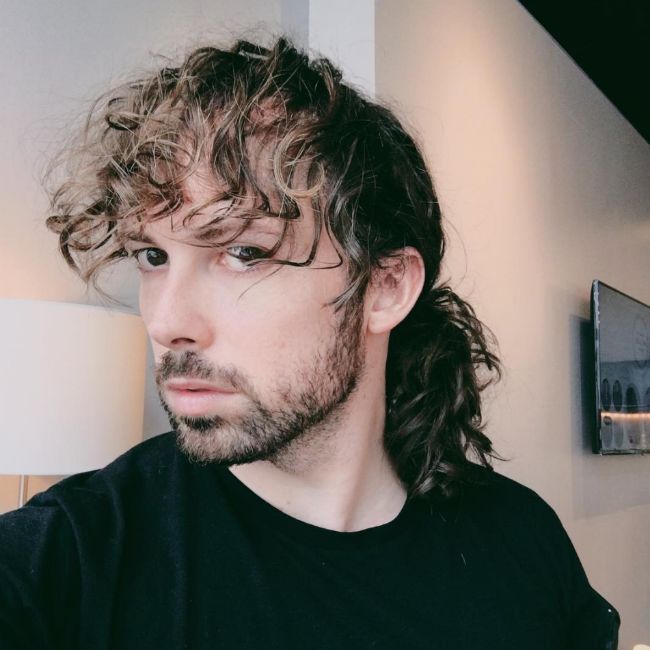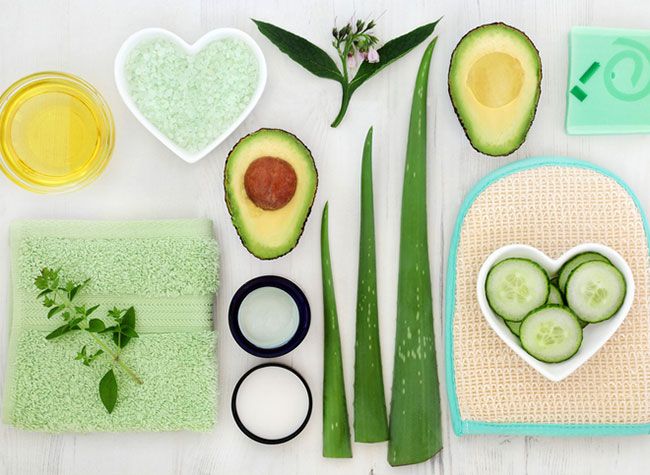Search Results: NaturallyCurly

1. Pineapple
This look is one of the classics of easy updos for type 4 hair for a reason. It is a great way to show off the beauty of your natural texture while still keeping your hair up so you aren’t tempted to play with it throughout the day. This is also one of the fastest looks to pull off in a hurry!
2. 10 Minute Twisted Updo
For those mornings when you don’t have a lot of time, this look is perfect. It’s fast and easy to do! This style gives you a nice amount of volume on top while still protecting your ends.
3. Fab French Braid
The French braid has always been a feminine and pretty style. It’s perfect for the office or date night. When put into an updo, it gives the French braid a more modern twist on the traditional style.
4. Flat Twisted Crown
When you want to keep your hair out of your face and completely put up, this protective style is the perfect option. It lets you create a summery look perfect for the beach or those days at the office when you’d rather be at the beach.
5. Twisted Pompadour
For a look that gives you a lot of volume on top with a sleekness in the back, the twisted pompadour is the one you want. It is easy to do and leaves you with a classy, stylish look perfect for any situation.
6. Twist N Bun
This style can be either a bun or a twist ponytail style. Either way, it is a cute and stylish way to keep hair back and protected. Whether going on a special date or just taking the kids to the park, this updo is a sleek look for the modern naturalista.
7. Mohawk
When you want a look with a little more attitude and edge, the Mohawk updo is where it’s at for curlies. This look is easy to do and popular on the curly hair scene.
One of the hottest superfoods on the scene is açaí and for very good reason. This small berry offers several health benefits, but do you know about the benefits of açaí for curly hair? Let’s take a closer look at what this berry has to offer for both overall health and the health of your curls.
Euterpe oleracea Mart., commonly called açaí (pronounced ah-SIGH-ee”>, is a palm tree that grows in South America and in the rainforests of Brazil. The skin of the palm tree’s berry is the part that is garnering public attention as a super food with miraculous healing qualities.
Açaí for your skin
The excitement stems from the high amounts of age-defying antioxidants that the berry skin contains. These flavonoids block diseased cells. A recent study shows that the bioactive polyphenolics present in acai berry reduce the proliferation of certain leukemia cells in a dose and time-dependent manner.
Açaí berry is a holistic healing herb that can be consumed in capsule form that still benefits hair, skin, nails, and vitality. It can be enjoyed as a refreshing juice drink or added to a smoothie. Today, several skin and hair care products contain açaí berry.
Açaía for hair growth
The amino acids and essential fatty acids found in acai skin make it a popular ingredient for hair hair products such as shampoos, conditioners, leave-in conditions, gels, balms, and pomades. This is why.
The Vitamins
- Vitamin B1 (Thiamin”> Vitamin B2 (Riboflavin”> Vitamin B3 (Niacin”> – While acai doesn’t contain the full B complex, the B vitamins it does contain are known to strengthen the hair and encourage hair growth. Deficient vitamin Bs in the system contributes to dry scalp, greasy hair, dandruff, retarded hair growth, graying hair, wrinkled skin, parched lips, dry skin, irritations and red complexion. These vitamins could be taken orally but many doctors are recommend getting them through foods, such as acai.
- Vitamin C – When combined with protein — which açaí also contains — this vitamin creates collagen. Collagen is essential for healthy skin. Ample C deters sagging skin and wrinkles. Vitamin C is responsible for keeping the skin moist, preventing lines and crinkling, spider veins, tangled hair and hair breakage by regulating the sebaceous glands. In addition, vitamin C benefits the eyes, teeth, immune system and skin.
- Vitamin E (tocopherol”> – Vitamin E is known to help prevent wrinkle and premature aging of skin and hair. Vitamin E also prevents dry, lifeless skin, hair breakage, and dandruff. It improves the healing of scars and wounds as well as overall circulation.
The Minerals
- Calcium – This contributes to hair growth, strength and healthy condition of hair.
- Potassium – This regulates the circulation improving hair growth and skin condition.
- Protein – Hair is primarily made of the protein keratin. Diets deficient in protein lead to all sorts of hair problems, including hair breakage, slow hair growth and thinning. Adequate amounts of protein in the diet are believed to accentuate hair growth, strength, and condition.
Amino Acids
Açaí contains a healthy amount of amino acids. Amino acids are constantly required by the hair follicles to maintain hair growth.
Açaí in hair products
The combination of acai berry’s vitamins, minerals, phytonutrients, EFAs and chemical constituents come together to greatly benefit the hair and skin. When it comes to the benefits of acai for curly hair, one of the biggest concerns of many curly tops, whether it be wavy, curly or kinky, is frizz which açaí helps to eliminate. Another one of the best benefits of acai for curly hair is the way the vitamins can strengthen and moisturize strands to leave them healthier. There are several hair care products that use this healing berry for just these purposes! The Surya Henna line uses açaí as a humectant and frizz buster. The Florestas natural hair care company also feature an açaí berry line. Açaí juice can be found in most well-stocked health food stores as well as acai supplements in capsule form.
Açaí for your health
Unlike some distasteful health foods, the açaí berry has a vibrant taste similar to dark-chocolate-covered cherries or blueberry ice cream with chocolate flakes. It tastes very interesting, which entices us to enjoy it for its many other positive attributes.
Benefits reported include:
- Greater energy and vitality
- Increased stamina
- Improved circulation
- Improved digestion
- Better sleep
- Improved sexual function
Açaí berry contains an array of vitamins, minerals, amino acids and essential fatty acids. It has more protein in it than an egg. It also contains good concentrations of Vitamins B2, B2, E, and omega 6 and 9.
Essential Fatty Acids in Açaí
Acai contains the EFA’s Omega 3, 6, and 9. The fatty acid content is similar to that of olive oil. It is also rich in oleic acid a monounsaturated antioxidant. Here is a breakdown on the beneficial qualities of the EFA’s contained in acai berry.
Omega-3
Alpha Linolenic Acid is the primary Omega-3 fatty acid. Omega-3s are helpful in forming cell walls keeping them flexible and improving circulation as well as oxygen intake. Omega-3’s help with mental abilities and memory function. Deficient Omega-3 contributes to poor vision, blood clots, poor immunity, increased triglycerides and bad cholesterol at increased levels; high blood pressure, irregular heartbeat, learning disorders, slower growth levels in infants, children and fetuses. It also causes menopausal discomfort.
Omega-6
The Omega-6 in acai berry skin (Linoleic acid”> is significant because of its numerous overall health benefits. Linoleic acid is the primary Omega-6 fatty acid. Omega-6 can improve diabetic conditions, rheumatoid arthritis, PMS, skin problems like eczema and psoriasis and help with cancer treatments. While many of us get an excess of linoleic acid in our diets it is not converted into useful gamma linoleic acid (GLA”> because of metabolic problems caused by bad dietary habits, smoking, pollution, stress, aging, viral infections and other illnesses.
Omega-9
Oleic acid, called Omega-9, is not considered an essential acid however it still contains significant health benefits. Omega-9 lowers heart attack risk, arteriosclerosis, and helps with cancer prevention.
ORACs
ORAC is an acronym that stands for Oxygen Radical Absorbance Capacity, a measurement of antioxidants in foods. Healthy consumption of ORAC-rich foods helps prevent premature aging. Scientists believe we need between 2,400 and 3,000 units of ORAC for health benefits. One serving of pulp juice prepared from the açaí berry skin contains a whopping 3,800 units of ORAC.
Anthocyanins
Another important constituent of açaí is anthocyanin. This provides some of the health benefits of red wine, yet the amount of anthocyanins in acai berry contains 10 to 33 times more. It contains twice as much anthocyanins as blueberries.
Check out these products if you want to incorporate Acai into your hair care regimen!
Many curly girls may have heard that bangs are for straight hair. This is simply not true!
Bangs can work with a variety of textures and hair types. When it comes to styling curly bangs, there are a few tricks of the trade that can make it easier to get the look you want for these face-framing hairs. Here are some of the best tips on styling curly bangs.
- DON’T heat-style them every day. For lots of curly naturalistas, getting your bangs to cooperate in the mornings can be challenging and so they turn to heat tools. If you are having a hard time getting your curly bangs to work with you instead of against you, we recommend minimizing the amount of heat you use on your hair. Especially when you use heat on one spot repeatedly, you will want to be careful to avoid heat damage. Use heat as infrequently as possible (we would not recommend using it every day”> and always use a heat protectant. You may want to focus protein treatments and deep conditioning in that area as well.
- DO style them wet. One of the best tips for styling curly bangs is to style them while wet or damp because it is super easy and effective. Simply apply your favorite curling cream to damp strands and curl the strands of your bangs around your finger. For second and third day hair, use a spray bottle with water to style them wet in the mornings, as you may find that your bangs are sticking straight up when you wake up in the morning.
- DON’T rub them with a towel. The hair on your bangs is most likely fragile. If you rub it with a towel, even a microfiber towel, you run the risk of not only creating frizz by raising the cuticle, but also creating a breakage problem. To dry your bangs, simply squeeze them with a microfiber towel, being careful not to create any friction.
- DO style them separately. Bangs need more attention and different techniques than the rest of your hair, so many curlies find it useful to style their bangs after they’ve styled the rest of their hair. Keep a spray bottle with water handy so you can refresh them and style them at the end of your styling session.
- DON’T trim them yourself. Naturalistas are do-it-yourselfers at heart, and many like to trim their hair themselves. BUT did you know that most stylists will not charge to trim your bangs? DIY trims are not for everyone, so if you are someone who has any trepidation about cutting your hair, then you might as well have a professional do it for free.
- DO find a style that works with bangs. Bangs are a great way to show off your curls and frame your face, but not every style will work with bangs. Here are a few pretty examples of styles that work well with curly bangs.
- DON’T pin them back on day 1. You may be tempted to pin your curly bangs back away from your face, sometimes you just need to breathe! We would not recommend doing this on day 1 of your wash week, because it will be difficult to wear them down due to creases on following days. If you typically wear your hair down or in a wash and go it would be best to do that for the first day or two of your wash week, and keep any pinned back styles for day 3 or 4.
When you’ve grown up accustomed to spotting one odd head of curls in a crowd, the connection you feel with that woman is magnified.
Most women with natural hair probably can’t imagine what it would feel like to be surrounded by thousands of other women who have embraced their texture. Thousands of naturalistas gathered in Brooklyn’s Prospect Park on July 15th to experience that feeling at Curlfest 2017.
Curlfest is your Instagram feed come to life.
You know the beautiful, painted women in your feed by makeup artist @moshoodat? They were walking around the festival, live, and covered in flowers.
The braids you’ve been Pinning to try this summer? They were being styled at Creme of Nature’s braid station, for free! Stylist Diane C. Bailey was working her magic at SheaMoisture’s pop-up salon. Tropic Isle Living was keeping our hair and our bodies hydrated with fresh cut coconuts. Mielle Organics founder Monique Rodriguez, along with her two daughters, launched their newest Mongogo Oil line. And this event wasn’t just about loving your hair, Iman Cosmetics had women embracing their skin tones as well.
And all of the natural hair gurus who inspire you daily were in attendance. All of them.
The festival, created by Curly Girl Collective, originally began as a meetup in the home of one of its founders, Tracey Coleman. What once started as an intimate group of women has grown to encompass men, families, and children. Some of the flyest styles at the festival were being rocked by the kids!
Here are some of our favorite looks and moments
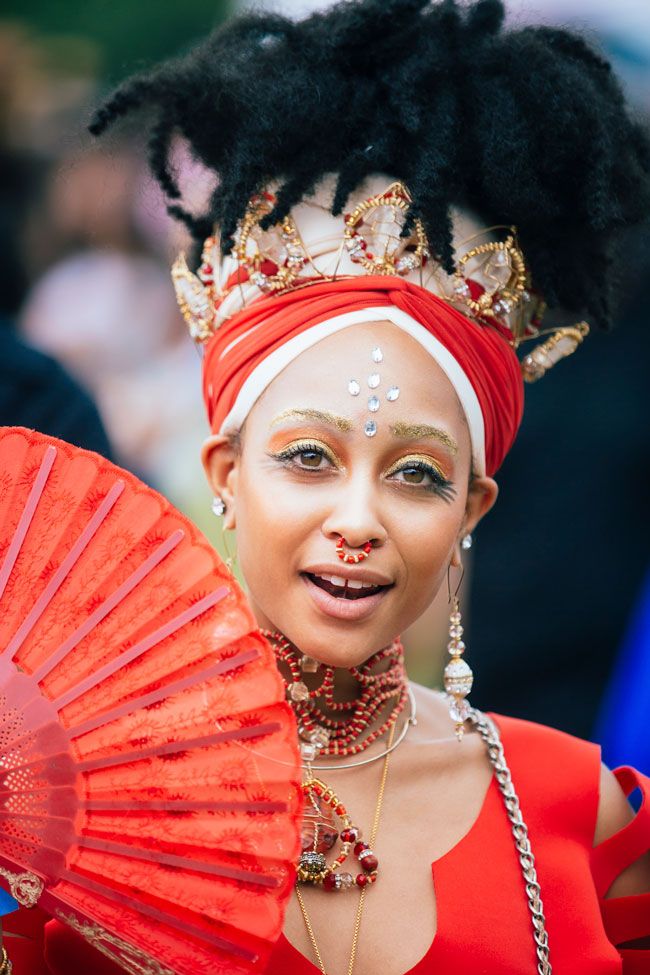


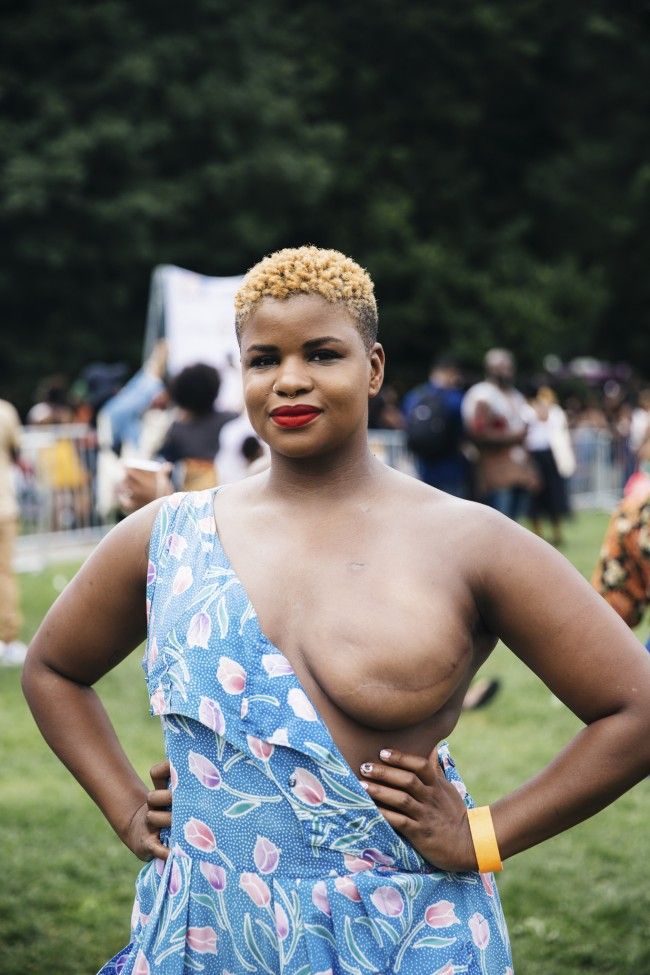
” src=”https://diana-cdn.naturallycurly.com/Articles/Mv_MARK3817-1.jpg”>
Photos by Mark Clennon
The scalp is the foundation for healthy hair. It is where the growth takes place and where natural oils are distributed from to properly moisturize your strands. When you have scalp problems, it can feel and look awful. The problem is that many people assume all scalp issues are the same in nature, when they are not.
When you have a dry, itchy scalp, you may make the assumption that it’s dandruff each time. However, there are many reasons your scalp could be having these issues, and if your assumption is wrong, you could be missing out on a treatment that would help. Many curlies often ask, “What is the difference between dandruff and a skin allergy?” Let’s look at the key factors to take notice of, and how to best treat them.
So, what is the difference between dandruff and a skin allergy?
You might be a little more familiar with dandruff since it is more common than an actual skin allergy. Dandruff leaves behind yellow flakes and makes your scalp feel dry and itchy. If left untreated, it will continue on this path and will eventually affect your hair health with symptoms like limp hair, irritated scalp, and dry scalp.
In contrast to this, a skin allergy tends to be more severe. Skin allergies will often be painful and look like a rash with raised, red bumps and maybe even blisters depending on the severity of the reaction. This is not to say that an allergic reaction is always this extreme. An allergic reaction can display itself as dryness and flakes, but the main difference is that there will be more discomfort than what is typically associated with dandruff.
The best way to know if it is an allergy is to pay attention to your symptoms. You should also consider if you have recently introduced any new products into your hair regimen that may be the cause of the reaction. If you have started a new product and are seeing rash-like irritation, discontinue the product to see if that makes a difference in your scalp health.
Another concern about dandruff versus skin allergies is that many people will mistakenly confuse dry scalp with dandruff. They assume that if their scalp is dry without flakes, it is still dandruff.
Dandruff’s main characteristics are the flakes of dead skin. If you incorrectly assume you have dandruff and you load up on dandruff products, you may end up making your dry scalp irritated. In fact, even an oily scalp can get dandruff. While many people think of dandruff as a dryness problem, it is actually more closely related to excessive oil production and other factors. According to an article in Everyday Health, “It is usually due to an overgrowth of harmless yeast,”explains Jessica Wu, M.D., a Los Angeles dermatologist and assistant clinical professor of dermatology at the University of Southern California Medical School.
In some people, the yeast starts to feed on the excess oil and dead skin cells on the scalp, causing the skin cells to shed more frequently and clump into flakes.” It is important to remember dry scalp and dandruff are two separate things.
When it comes to treating dandruff or dry scalp, it is best to watch for flakes and then proceed accordingly. If your symptoms continue it is recommended that you consult with a dermatologist, doctor, or even your hair stylist about your dandruff concerns to find the right solution.
Typically, an over the counter shampoo and treatment may be enough, but if it is severe, you may need to see your doctor because it might be an underlying medical condition.
Have you experienced an allergic reaction to hair products before?
Products and tools can be an essential part of our healthy hair regimen, but with products and tools comes their upkeep, which many people tend to skip. For instance, when’s the last time you remembered to clean your brush? Like a serious deep clean? Never, Right?
A dirty hair brush or comb can get pretty gross pretty quickly, and oftentimes we don’t even realize we are putting bacteria in our hair by not cleaning them often. It can also make the brush less effective at working out tangles because it is full of previously shed hair, dust, lint, and dirt. The best way to combat this buildup getting back in your strands though is with an effective deep clean. Running them under the faucet isn’t quite enough, but the cleansing process is super easy and can be done rather quickly. So here are 0ur 5 steps for effective brush and comb cleansing!

Step 1.
Make a mixture of warm water and a few drops of shampoo. You need to use a bowl or mug that is large enough to soak the brushes or combs in for a fully submerged cleaning solution. If the shampoo still leaves buildup, you can try a white vinegar soak to remove excess oils. Let it soak anywhere from 10 minutes to 30 minutes, depending on the buildup. Make sure you remove any strands of hair from the combs and brushes prior to soaking.
Step 2.
Use an old toothbrush on your combs to clean thoroughly between the teeth. A toothbrush should be able to get all the buildup off after a good soak.
For brushes, run the brush under the faucet to remove the cleaning solution and dirt. You can also add a little extra shampoo and massage throughout the bristles prior to soaking to help loosen the buildup.
Step 3.
After soaking the brushes and combs, the next step is to use the comb to clean the brush and vice versa. You want to gently scrub the bristles of the brush with the comb to help remove any leftover strands.
Step 4.
Rinse the brushes and combs with, preferably hot water.
Step 5.
Set them aside to dry on a towel. Some people recommend drying them with a hair dryer when you are in a hurry, but be careful as heat might damage the bristles of the brush, depending on the heat used and the type of bristle.
When it comes to keeping your brushes and combs clean, we have found these steps are the easiest and quickest way to get the job done. Clean tools mean clean and healthy hair, and we all love that!
Want more tips on how we practice hair maintenance?
For more helpful articles like this, sign up for our newsletter!
*Location and Last Name have been omitted for privacy*
Being deployed and headed to a new place, I had very little idea of exactly how different the climate would be from my home town. When we arrived at base, it was 29 degrees outside and in the middle of the rainy season. It rains about every other day and the rain comes in one of two ways, either a light constant drizzle or a torrential downpour. In the summer, the temperature rises to about 130 degrees, and the wind feels like a blow dryer in your face on the hottest setting.
Having natural hair, I figured I would research the methods of the people who currently lived here to see how they took care of their hair. I Googled the “Indian Oiling Method” and proceeded to collect mass quantities of avocado, coconut, jojoba, tea tree, and Amla oil. While this method didn’t exactly work for me, I found a really strong routine that has helped keep my curls moisturized and protected. I also packed a ton of raw Shea butter, salon-size bottles of shampoo and conditioner, a handful of my go to moisturizers and products, and an empty spray bottle.
Between making sure my hair was constantly moisturized, utilizing protective styles, and also making sure my routine was quick, I think I found a good system that works for my hair while being deployed!
Daily Routine
Throughout my time being deployed, I quickly learned not to rely on buns for my hair, but instead with either cornrows or 2-strand twists. There is power in numbers and my hair felt noticeably better when it was clumped together.
Secondly, I would sweat just from standing still, so I washed my hair super often. In order to combat dryness from the increased wash days, I would use bottled water in my spray bottle, which I would use to spray my hair twice a day.
In the morning, I followed up with Cantu Shea Butter Leave In Conditioning Repair Cream then seal my strands with Tropic Isle Jamaican Black Castor Oil depending on my daily activities.
For instance, if I knew I would be outside for most of the day or if it was the day before wash day, I would use a thicker oil and then use a lighter oil (such as coconut oil”> every other day. All products were also applied end to root, to protect my ends.
Wash Day
My wash-day routine consisted co-washing with Shea Moisture High Porosity Seal Co-wash every week, and every three weeks I would use EDEN BodyWorks Tea Tree Oil Shampoo and Tea Tree Oil Conditioner. After each shampoo use I would deep condition with TGIN Honey Miracle Hair Mask and follow with the LCO (liquid, cream, oil”> method.
Before using shampoo, I would oil my hair the day before to try to protect it from losing too much moisture. I still managed to do a protein treatment every six weeks, just like back home, but because of time, I found a holy grail product in the Two Minute Intensive Keratin Reconstructor by ApHogee. You don’t get very much time in the shower, so my wash day routine had to be spot on and efficient. I currently wash my hair in twists/braids and then redo them afterwards. This method helps me to to ensure that every strand gets moisturized.
Take Aways
My biggest takeaways since I have been deployed have all been focused on moisture and protecting my hair. Here are my top 4 tips I learned for managing a different climate and keeping my curls in tact:
- Don’t skip wash days. It does get busy and you don’t have much time, but your hair and scalp will appreciate the consistent love.
- Protective styling is my best friend. Between flat twists and two strand twists, I have an entire routine down for styling my hair on the fly and locking in moisture.
- Unless you have a TWA, it’s not a good idea to leave your hair out. It will definitely dry out faster, so this is where the protective styles come into play.
- Moisturize! Moisturize! Moisturize! Especially during the summer months, and oh yeah, moisturize!
Thank you so much to our reader, Robyn F., for submitting this story to us!
Born in Jamaica and raised in Florida, Robyn is an active duty member of the United States Navy. She started blogging and vlogging her curly hair journey after being deployed overseas and needing to find a way to take care of her hair. She has a passion for creating art through various mediums, with writing being one.
Want to pitch your story to NaturallyCurly.com? Shoot us your idea here!
There are many natural ways to reap the benefits of nature’s finest ingredients. From green tea extracts to coconut oil, nature has provided us with various healing properties that can be used for your hair. If you are familiar with essential oils, you know they offer several forms of healing benefits for hair and skin. When it comes to using essential oils for your children, a question that comes up a lot would be is hemp oil safe for my children’s hair? You don’t have to worry any longer, below you’ll find out the benefits of hemp oil and few ways to cocktail it at home for you and your little ones.
Is it safe?
You will be relieved to know that hemp oil is indeed safe for your child’s hair. In fact, hemp oil can be used on babies without any recorded side effects or negative consequences. Hemp oil is great for use on curly hair because it is rich in fatty acids such as Omega 6 and Omega 3. These nutrients are known to help make hair stronger and healthier. Hemp oil is perfectly safe for your little ones! Maria Angeles Fernández-Arche, PhD and professor at University of Seville and colleagues found in a study that some components in hemp oil, including sterols, aliphatic alcohols, and linolenic acids, contain an abundance of fatty acids that offer many types of advantages for you and your body. “The high amounts of linolenic acid (17%”> may have favorable nutritional implications and beneficial physiological effects on the prevention of coronary heart disease and cancer.” Hemp is a crop full of oils with potential health benefits! Below we introduce how you can incorporate it into your hair care routine.How to Use
There are some dosage guidelines to follow when administering hemp oil as part of a diet, but when it comes to using it on the hair, there are no restrictions. You can use it on your baby, toddler, teen, and every age in between without worry. An allergic reaction is a rare and isolated event with hemp oil. There are many products which already include this essential oil for children. In fact, since most formulas with hemp oil in them tend to be all-natural. You can use products not intended for children in most cases.
You can also cocktail hemp oil in your hair treatments using essential oils. You can purchase organic hemp seed oil and simply add 1 tablespoon to your child’s leave-in conditioner a few times a week for an added measure. Another way to get the results you want from hemp oil is to apply it directly to the hair. The amount you use will depend on the length and porosity of the hair. When using this oil, you don’t need to rinse it out. Your child’s hair will see more benefits if the oil is left on overnight.
When it comes to hair care for your little ones, it may seem concerning trying to figure out the best options. With a little hemp oil, you can give them the TLC they deserve and watch their curls transform!
Have you used hemp oil for your littles one’s hair? We’d love to know what you thought.
The scalp is the key to great hair.
When your scalp is irritated, inflamed, dry, or itchy, you just don’t feel that great about your hair. When it comes to irritated scalp bumps and treatments to put an end to them, there are some easy solutions to get your scalp health back on track. Your first step:
Find the root cause
For most people, scalp irritation will show signs as dryness, itchiness, or slight discomfort or pain. When bumps or redness appear, it is usually a sign of something more serious. If your scalp has raised, red bumps that are painful, you should consult your doctor for the best advice on how to go about taking care of the issue. There are some problems with the scalp that require treatment from a dermatologist so make sure you take care of any scalp issues ASAP instead of hoping they will go way on their own. Here are a few causes of red painful bumps on the scalp and ways to treat the problem.Ringworm
This is a painful infection of the scalp caused by fungus. It requires medical attention and will not go away if left untreated. While this is more common in children, adults are still vulnerable to ringworm. Since this is a contagious and fast-spreading fungus, it is important to treat it immediately. A doctor will prescribe a medicated shampoo as well as anti-fungal topical solutions to kill the fungus and provide relief.
Folliculitis
This condition happens when hair follicles become infected and inflamed. The bumps are red and itchy and have the ability to affect other parts of the body besides the scalp. Folliculitis is usually caused by bacteria or fungus that accumulates on the follicles due to a lack of proper hygiene. For this condition, many people find relief from the red, itchy bumps by washing with a mild shampoo every other day. Using tea tree oil shampoo is a trusted remedy as it acts as an antibacterial solution for cleansing the scalp. Consult a doctor for a stronger topical remedy to get rid of the red bumps if your case feels extreme.
Psoriasis
A common problem of the scalp, this condition will leave the scalp with bumps and itchiness along the hairline. It can cause flaky patches that are hard to hide and embarrassing for most people. Psoriasis is caused by many different factors such as a weakened immune system, the flu, a skin infection, or stress. The best way to treat this condition is with salicylic acid, retinoids, corticosteroids, and other topical creams intended to moisturize and encourage healthy cell turnover needed to provide relief. Try a balancing conditioner with African Black soap for a soothing difference, too.
To sum it up
When it comes to your scalp there are many reasons for issues to come up. The key to a healthy scalp is paying attention and reacting to problems as soon as possible.
Read How to do a Vinegar Rinse for Removing Dandruff
For more helpful articles like this, sign up for our newsletter!
Regardless of where your hair falls on the texture spectrum, all curly girls have dealt with hair drying issues. If you prefer to use a heating method, your hair can incur damage that leads to dry, brittle strands that are prone to breakage. If you air dry, you might be battling a case of the frizzies all day, or worse, a bad hair day on repeat. What’s a curly girl to do? Well, one popular option that curlies are using is the method of braiding their hair and letting it air dry. While the braid out method certainly isn’t anything new, it is becoming a more popular option as more and more curlies embrace their natural texture and want to avoid heat damage.
Why braid your hair?
Here are a few reasons to consider leaving your blow dryer behind, braid your hair and let it air dry instead.
- It is less damaging to your curls. Heat is known to damage your hair, especially when applied on a daily basis.
- It’s a useful solution for those who have multiple textures or are transitioning and want to style their hair with one uniform texture.
- You can create two styles in one day. When you start your day, your freshly washed strands will be up in a braided style great for a no-fuss day at work. Later in the day, when they have dried, take them down for a full-bodied look perfect for whatever the night holds.
- It works for all textures. Depending on how big or small your sections are, you can either make your texture looser or tighter than it is naturally. It can be used to stretch tighter textures, and create volume and definition for looser textures.
So, how do you go about trying this method?
Step 1. Wash and condition as usual.
Step 2. Towel dry your hair. The idea is simply to remove as much excess water as possible. Using a microfiber towel or an old cotton t-shirt to avoid raising the cuticles and causing frizz, absorb as much excess water as you can without rubbing hair.
Step 3. Coat your locks in your favorite leave in conditioner or frizz fighter. This will help make it easier to braid while ensuring your look stays frizz-free and defined while drying.
Step 4. Braid hair. There are many styles to try, but a popular choice that is fast and easy is a simple French braid style. The smaller the sections, the tighter your texture will look when it dries.
Step 5. Live your life. Seriously, that is one of the best parts about this drying method is that once the braids are in, you are free to carry on with your day without much worry about your hair. If you saturated your hair in enough conditioner, you won’t even have to think about daytime frizzies sneaking up on you.
Step 6. Take it down. When hair feels completely dry to the touch and your scalp feels dry, you can take out your braids. The amount of time it will take to dry will obviously depend on several factors such as your individual hair type and texture, the length of your hair, and the products you used to condition.
Step 7. Evaluate. Once you have taken down your braids, run your fingers through hair and see if you need to apply a little touch of product to your ends.
The next time you’re in a hurry and don’t feel like dealing with the hassle and heat of the blow dryer, try this method out for yourself!
There are a few cold shower hair benefits that might make you change your mind and that temperature dial.However, there are also a few myths about cold shower hair benefits. Here are a few of the most popular truths and myths about cold shower hair benefits to keep in mind.
1. Fights frizz
One of the biggest myths about cold shower hair benefits is the one about frizz. This isn’t necessarily a myth, but it isn’t entirely true either. Using hot water can cause frizz by making the cuticle expand. While hot water isn’t great for your cuticles, the common myth that cold water seals strands isn’t true. It simply doesn’t open up and inflate the cuticles the same way hot or warm water will.
2. Detoxifies
The myth that cold water is better at detoxifying hair and scalp is not factual. Cold water has a harder time moving dirt, debris, and excess oil away from the scalp. With hot water, you can open up the scalp pores to get a deeper cleansing, but do so in moderation or you run the risk of drying out the natural oils you need for a healthy scalp.
3. Stronger strands
This one is complicated. The idea behind this is based on the idea that cold water can seal the cuticle. While we know this isn’t the case, it is true that hot water used too often can contribute to dryness which leads to brittle strands. The dryness will eventually break down the protein bonds needed for hair to remain strong and fortified. Since cold water doesn’t raise the cuticles as much as hot water, your strands will be better protected from this and will, in essence, be even stronger.
What it CAN do
Colder water can help with hydration. It is no secret that hot water robs your hair of natural moisture elements. When you wash with cold water, your hair will be able to retain those natural oils more easily to lock that moisture in instead of depleting it. It is also easier for hair to absorb cool or cold water molecules than hot ones.
The cold water benefits versus hot water are still up for debate. You can still benefit from using cooler temperatures by following the basic guidelines related to the topic such as using hot water for deep cleansing but limiting how often you use hot water, sticking to cooler water to avoid raising the cuticles as much, and rinsing with cold water before stepping out of the shower to help with hydration.
Want more tips like this?
For more helpful articles like this, sign up for our newsletter!
Healthy curls aren’t just for the ladies.
Men may have differing style goals from women, but the common care concerns are pretty much the same in terms of moisture. When it comes to keeping curls looking their best, moisturizing for curly guys is essential. So, what should you look for when choosing products to tackle moisturizing for curly guys? It is important to know that not all conditioners are the same in purpose. Here are the ones to know.
In-shower conditioner
If guys are using a conditioner, then most of them – curly or not – are probably using this type of conditioner. As a basic conditioner used during a shower, most curly guys run it through their hair and immediately rinse it off. A good tip is to massage the scalp with it for two minutes to get the most benefit out of the product. You also want to look at the ingredients being used to make sure they will give you a dose of moisture.
- Tip: Look for ingredients with natural emollients like jojoba oil, coconut oil, and other natural ingredients. A sign of good conditioner is usually if water is included in the formula because water combined with other factors is what replenishes moisture loss. TGIN Triple Moisture Replenishing Conditioner is light enough for everyday use but still packs a moisturizing punch.
Leave-in conditioner
The difference between a regular daily conditioner and a leave-in conditioner is that one gets rinsed out of the hair in the shower while the other stays in your hair all day long (or until you shampoo again”>. A leave-in is usually thicker and richer than a rinse-out conditioner. A leave-in can be used either in place of in shower conditioner or following it when strands seem extra dry or brittle. Most curly guys use a leave-in conditioner every day to every few days.
- Tip: What you want is a leave-in that will be able to saturate strands without adding too much weight. A few good products for this are As I Am Leave-In Conditioner and G’Natural All Day Leave-In Conditioner.
Deep treatment conditioner
The final aspect of conditioning curls for men is a deep conditioner. This is usually used when hair is damaged and in need of repair, but it can also be done as a protective measure before damage strikes to fortify strands. For this product type, you will apply it to clean, towel-dried strands and then wait a time frame of anywhere from 20 minutes to an hour, depending on the product instructions, and then rinse out. These formulas are not usually intended to be left on hair in the same way as a leave in because they are often thick, giving hair a quick boost of nutrients and vitamins so look for products packed with natural ingredients.
- Tip: Most curly guys find it is helpful to use a deep conditioner every 2 to 3 weeks. Try Creme of Nature Argan Oil Intensive Conditioning Treatment and Alex Anthony Curl System Restore Intense Conditioning Treatment. For this product, you will typically use it based on your own evaluation of the state of your curls.
Taking care of your curls is important. With the right moisturizing products and routines in place, your hair will look better than ever!
When it comes to keeping your scalp and strands healthy, there are tons of products on the market.
Sometimes, you can create the perfect remedy right in your own kitchen! When dealing with dandruff, you may have tried every product available and still can’t get the results you want. One way to take matters into your own hands is by mixing up your own vinegar rinse for removing dandruff!
What is apple cider vinegar used for?
In a natural hair regimen, apple cider vinegar (or ACV”> can be applied to the scalp for its powerful abilities to break up harmful bacteria with the acidity of the enzymes in the solution. It also a natural antibacterial agent that works against the bacterial and fungal infections that are known to cause dandruff in the first place.
Where can I get it?
This simple solution can be found at nearly any grocery store and is used for many purposes.
- Wash your hair to remove any excess oils or hair products.
- Dilute the vinegar to a level you are comfortable with. It may have an acidic smell that you find bothersome. If this is the case, feel free to dilute to your preference. If you have only mild dandruff, diluting it with warm water it is a great way to make sure you get the right amount. For more extreme dandruff, add less water to the mix.
- Apply to areas with known flakes or to the entire scalp, depending on your case.
- Let the vinegar sit on your scalp for about an hour.
- Rinse with warm water — do not not use a shampoo.
When making the vinegar rinse for removing dandruff, there are some things to keep in mind.
- Always do a patch test on a small part of your scalp to see if you are sensitive to the vinegar rinse prior to covering a large area. It is rare to have a reaction, but it is better safe than sorry.
- After the test patch, monitor your skin for signs of irritation before proceeding with the treatment.
- Organic vinegars are usually better than other options because the ingredients are often more concentrated without additives.
- Apply vinegar in a well-ventilated area to avoid eye irritation.
Want more DIY recipes for your scalp? Read these:
Showing yourself TLC is more important now than ever, and the good news is there are countless ways to practice self-care. From facials to pedicures, head to toe care is a great practice. While many people indulge in body massages to remove stress and tension from tired muscles, there is one area that is often forgotten. A scalp massage is one of the most beneficial acts of self-care for a curly girl because it makes your scalp healthy and leads to healthier hair. Plus, it’s cheap, quick and easy – which can’t be said for a lot of curly hair methods. Go ahead and take 5 minutes to give yourself a scalp massage today, this is how.
1. Find the right product for the job
You can do a scalp massage on dry hair, especially for a quick pick me up at your desk, but it will feel even more relaxing and spa-like on wet hair with an oil treatment. A dry massage is great for a quick pick me up during the day, but an oil massage is a longer lasting, more indulgent act of self-care. When choosing oils for this purpose, choose options rich in essential vitamins such as B and E to help restore health. You should also opt for an oil made of natural bases such as argan oil or coconut oil for moisture that won’t add buildup with unnecessary chemicals.
2. Trim your fingernails
When getting ready to treat yourself to a scalp massage, it’s important to make sure your nails are short and trim. If you’re massaging your scalp and using fingernails to do so, you may end up scratching your scalp. Nails are known for harboring small amounts of bacteria underneath them, and these small abrasions or even cuts can end up with bacteria from your nails. When massaging, try to use your fingertips, but not your nails to avoid damaging the skin on your scalp. It may be tempting to use your fingernails, but instead try varying the pressure when massaging to get the same effect.
3. Oil first and then wash
Some people will wash their hair prior to a scalp massage, but there is a good reason to wash after the treatment instead. When you use an oil treatment to massage your scalp, you are mixing your natural oils with the oil product for a more evenly distributed and natural method. If you apply it to a clean, freshly washed hair, you have already naturally stripped away some of the natural oils. When using an oil treatment, think of it as phase one of your scalp massage with the wash step being phase two.
4. Work in circular motions
It is best to massage in circular motions because this encourages blood circulation which helps keep the scalp healthy and can promote hair growth. While washing the oils out of your hair, remember to continue the circular massage motion to help cleanse and restore the balance of natural oils.
Massage for about 3-5 minutes to reap the most benefits.Don’t perform this beauty treatment too often or you may end up with an irritated scalp. Once a week is a good guideline for most people.
When it comes to a great way to relax and pamper at home, a scalp massage is the perfect quick fix. Keep your hair and scalp happy with these easy tips!
If your curls need definition and moisture, you need Sachi Inchi oil in your life.
Sashapure Perfectly Defining Curl Cream is a new styler and maintenance product on virtual shelves, CVS, Walmart, and Ricky’s (find locations near you now“>. It is formulated with USDA Certified Organic Peruvian Sacha Inchi oil, the curl boosting emollient that adds softness, sheen, and volume to curly hair of all textures, especially curl patterns 3 and 4!
Sacha Inchi Oil heals and nourishes curls!
The curl cream not only gives your curls obvious definition; it hydrates strands while shielding them from humidity, which ultimately results in frizz. It is also packed with strengthening fatty and amino acids thanks to Sacha Inchi Oil.
As noted by blogger and researcher Sabrina Perkins, Sacha Inchi “is the seed of a plant that grows in South America.” Sashapure sources its sacha inchi oil from Peru.
From the brand:
“Did you know the Sacha Inchi seed starts its life inside a small 6 lobed green pod? The harvested pods are sun-dried until they turn a dark brown and split open, revealing the Sacha Inchi seeds. Once the seeds have been extracted they can be roasted and the oil can be used in a number of ways for strengthening skin, hair and nails.” –Sashapure
Now, you can enjoy the remarkable benefits of this powerful oil!
Thanks to Sashapure Perfectly Defining Curl Cream, your curls will bounce and shine like never before! Simply apply a quarter size (or more”> amount to towel-dried hair, evenly distributing throughout the hair, from tips to roots. For amazing curl definition, diffuse or air dry your curls. It is just that simple!
To see how beautifully this curl cream works, watch our Sashapure-sponsored video now on Instagram:
Enter the Sashapure Perfectly Defining Curl Cream Giveaway right now!!!
5 lucky winners will win the Sashapure Perfectly Defining Curl Cream. All you have to do is leave a comment below telling us why you want to win! You can also enter on Instagram and Facebook.
Want to try it? Visit Sashapure now to buy it online.
This giveaway was open to U.S. residents only, as per our Terms and Conditions.
This giveaway is now closed.
*Please make sure you have liked us on Instagram and Facebook, so that we can notify you if you’ve won!
Learn about the curl definition and styling technique that wavies, curlies, and coilies are excited about: Rake & Shake.
This styling technique not only provides curly hair with definition but helps to combat frizz when the Ouidad Advanced Climate Control regimen is used. Ouidad, the hairstylist who founded the first salon dedicated to curly hair in New York in 1984, created this signature method that’s now used in salons and by fans of the product line.
Rake & Shake Steps:
Prep: Fighting frizz starts in the shower: Cleanse your curls with Ouidad Advanced Climate Control Defrizzing Shampoo and Conditioner.
1. Starting with clean, damp curls, apply a foundation product such as Advanced Climate Control Detangling Heat Spray to prime hair for styling.
2. Separate hair into five sections, securing each with a clip.
3. Beginning with the section at the nape of your neck, rake a nickel-size amount of Advanced Climate Control Heat & Humidity Gel through curls from roots to ends.
4. While holding the ends of your hair, shake at the wrist to encourage your natural curl pattern to reform.
5. Using a nickel-size amount of gel for each section (more or less depending on hair thickness and length”>, repeat the raking and shaking motions on each of the remaining four sections.
6. Diffuse dry your curls on a low, warm setting—or allow curls to air dry.
7. Once hair is dry, rub a small amount of finishing product (such as Ouidad Clear Control Pomade”> between palms, hold your curls in a ponytail, and run your hands over your hair to open the curl.
Just like that, your curls will be super defined and ready to take on the elements. So, take your styling routine to the next level with the Ouidad Advanced Climate Control regimen and the Rake & Shake technique at Ouidad.com.
How will you redefine your concept of frizz?
Share your goals with NaturallyCurly and Ouidad in the comments below!
If you’d like to share how you have conquered frizz with Advanced Climate Control®, post your selfie tagging @Ouidad and #NotTodayFrizz on StyleNook today!
The DIY trend is nothing new. Women have been whipping up concoctions for their hair and skin since the beginning of time. Just because it is a common thing for most curlies doesn’t mean everyone is familiar with the pros and cons of DIY beauty products. Whether you are new to the DIY trend or you have never really thought about the possible negatives to your usual at-home concoctions, here is a brief list of the pros and cons of DIY beauty products.
The Pros of DIY
You can trust the ingredients
One of the best things about making a DIY beauty product is you know the ingredients are safe and non-toxic. When you purchase a hair or skin care product at the store, you have to study labels to find the ones that meet your standards. Sometimes, even products that claim to be all-natural have added ingredients such as fragrances which can be grating to your skin or other chemical compounds that are not necessarily great for you. With at-home blends, you know the ingredients are natural!
You can customize it
When you make your own beauty products at home, you can create exactly what you want, unlike store bought products. If your hair needs a boost of protein, but without added fragrance or added sulfates, you can whip up something that focuses on the protein element without all the unnecessary frills. Do you prefer a certain essential oil? Are you allergic to a particular type of oil? By taking a DIY approach to self-care, you can make something just right for you.
Natural ingredients are in your kitchen
Have you ever run out of your favorite shampoo, styler, or conditioner at the worst possible moment? Of course, you have! When you don’t have time to run to the store, you can find a ton of options using the ingredients you already have on hand. Thanks to the Internet and the fact that the DIY craze is so popular, you can find a recipe with just about any ingredients you have on hand.
Save money
There is no denying that beauty products can be costly, especially if you are aiming for the quality you rightfully deserve. With at-home treatments, from facials to hair masks, you can save a little bit of money. Why buy something expensive when you can whip up a concoction that gives the same results?
It is fast, fun, and easy
As if all those pros weren’t enough for you, let’s not forget that making a few DIY beauty products here and there is fast, fun, and easy. Most recipes take only a few minutes to create and you don’t need to be a chemist to create the perfect solution for your beauty needs. It is also fun to make something with your hands. You will get a sense of accomplishment, as well as beautiful skin and hair which sounds like a pretty fair return!
The Cons of DIY
Slower results
This is one of the bigger drawbacks to making at-home beauty products. You may see results faster if you use store-bought products than DIY blends. Obviously, it depends on the recipe, ingredients, and what you are trying to treat. For example, if you do a frizz fighter recipe for hair, you will get more instantaneous results than a dry skin recipe. It depends on many factors, but in general, store bought products tend to give faster results than DIY recipes.
Short shelf life
Another thing about at-home beauty products is that they have a shorter shelf life than store bought products. At-home products using natural ingredients are more prone to bacteria and mold. While most recipes will tell you how long a recipe will last safely, it depends on the environment you store it in as well, but it is based on the ingredients. For example, if you make a recipe with perishables such as milk or eggs, you need to use it right away or within a day or two to avoid it spoiling. While this may seem like a con, and for some curlies it is a hassle, the good news is that the reason your at-home beauty products spoil is because they are free of the chemicals found in store bought products! Store-bought beauty products contain preservatives to keep the ingredients from having a short life span.
DIY beauty products can be a great way to treat yourself or used as part of your regular routine. No matter when you use them, they have more pros than cons which is beauty you can feel good about!
Aside from being a nice morning pick me up in a cup, coffee is loaded with antioxidants, caffeine, and other mood-boosting properties. While all these elements combine to make coffee the powerhouse it is, the caffeine is where it’s at in terms of skin benefits. Aside from the exfoliation of dead skin cells, the caffeine in the coffee exfoliator can also help with inflammation, skin smoothness, cellulite, eye bags, and overall circulation for younger, healthier skin. Sounds like a winner, right? Before you go grab this morning’s coffee grounds and accidentally irritate your skin, there are a few things you should know about this exfoliating powerhouse.
First, if you are looking for a quick buy for this as opposed to making your own, there are some products on the market that are using coffee in their recipes. A few great examples are Art Naturals Organic Arabica Coffee Scrub, Coffee and Grapefruit Scrub, and others. The thing with buying a coffee based product is that it is formulated to be able to last for a while without taking on mold, fungus, and other bacterial growth which would make it unsafe, so make sure you check the labels for any ingredients or additives you are trying to avoid. If you are looking for a quick DIY approach to this beauty trend, it is really easy and you can rest assured the ingredients are safe and natural.
Coffee ground PSA
You should never take coffee grounds, either fresh ones or used, and directly rub them on your skin, especially your delicate face. They are too abrasive when used directly. The way to get the best results is to follow a recipe calling for coffee combined with other ingredients to soften the abrasiveness.
Here is a good, basic recipe to try out this skincare trend for yourself.
Coffee Exfoliator Recipe
- 3 tablespoons of freshly ground coffee grounds
- 1 tablespoon natural oil such as olive oil, almond oil, or coconut oil
- 1 tablespoon brown sugar
You should begin by mixing the dry parts of the coffee grounds and sugar before adding the oil. Add your chosen oil. Stir until all ingredients are combined. If it feels too grainy, add more oil to your liking and continue stirring. You can also adjust the brown sugar to make it thicker, but be careful not to add too much that it becomes overly abrasive. Using circular motions, massage the mixture on your face and then rinse with warm water. You should see and feel noticeably smoother and softer skin. You can make this a weekly routine or every week if your skin experiences sensitivity from it.
Coffee for your scalp
Coffee can be used for all sorts of beauty trends. When looking for a way to add this powerhouse to your hair, a scalp treatment is a great idea! Coffee has antioxidants in it that can block a harmful hormone known as DHT. This hormone contributes to baldness and hair thinning. With a coffee hair treatment, you can protect your hair against this pesky problem. The best way to use coffee for this purpose is to focus on the scalp. The scalp is where growth starts so you will be encouraging new growth while combatting hair loss. Coffee also helps with circulation which is key in overall scalp and hair health. It also exfoliates the scalp so if you are dealing with dryness and dandruff, this would be a big help.
The best way to use coffee for your scalp is by adding brewed coffee grounds to your favorite oil such as olive oil or coconut oil. Simply add your desired amount of grounds to the oil and massage into scalp using circular motions. Rinse out of hair with warm water.
What’s next?
Try this coffee rinse for extra shine.
Learn more about how coffee can be used to fight excessive shedding.
For more helpful articles like this, sign up for our newsletter!







